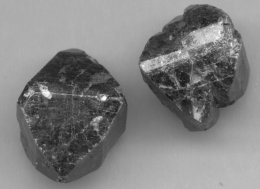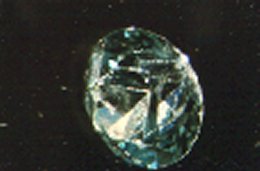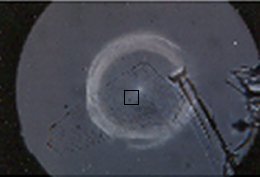Zircon is a relatively recent addition to the list of gems that are commonly worn for personal adornment. Its usage goes back only to about the last decade of the 18th Century. The stone has probably not enjoyed a highly successful usage such as has diamond, ruby or sapphire, and there are several reasons for this. First, zircon is relatively unstable as far as gemstones go. For example, on an important anniversary, a very wealthy man presents his wife a pendant with a very large faceted blue zircon in it. She wears it to the country club for dinner and dancing that evening and wears it on the next couple or three important social occasions. Then she decides that the stone is really too large and valuable to wear except on the most important social events and puts the piece away in a safe. The next big occasion is a few years later when her husband is promoted to chairman of the board. She decides to wear that pendant to the directors' annual dinner and takes it from the safe. Much to her horror, she discovers that the facet junctions on the stone are marred and dulled by numerous tiny chips that weren't there three years ago. It turns out that zircon has this nasty habit of chipping out at the facet junctions.
Metamict is a term that is applied to radioactive minerals or ones that have substituted radioactive elements in the crystal lattice that leads to disruptions in the crystal lattice and atomic arrangement within the crystal although the crystal retains its original external morphology. Zircon is one of these metamict minerals. Radioactive elements are characterized by a decay of the nuclei of their atoms. As Uranium 235 (U235) breaks down, Alpha and Beta particles and Gamma Rays are emitted. The Alpha particles have a rather large mass and as they are ejected from the nucleus of the atom, the effect on the crystal lattice is the same as if one was locked in a room and began firing a pistol in random directions. There would be bullet holes all over the walls, floor and ceiling of the room. As the alpha particles move at high velocity through the crystal lattice, the effect is similar. The alpha particles leave their paths of damage or "bullet holes" in the crystal lattice. These paths are called fission tracks. It is the damage to the crystal lattice that is caused by radioactive decay of elements that is the cause of the chipping of the facet junctions.
Absolute dates are the numbers in years of the ages of rock samples taken from the earth. Not every rock in the earth is the same age and these fission tracks, as much of a pain they may be to the jeweler or gem fancier, are very useful little clues that help geologists date rock samples. Uranium 235 breaks down at a constant rate, or it has a known half-life, the length of time it takes for half of a given quantity of a radioactive mineral to break down. If a radioactive element has a half-life of one million years, then if you start out with 2 kilograms, in one million years it will break down yield one kilogram. It is also going to fire out a lot of Alpha particles into the surrounding medium. What geologists can do is count the number of fission tracks in a given area or volume. The tracks are very tiny and at first, a thin section of rock must be cut and it must be etched in Hydrofluoric Acid (HF) to enlarge the holes so that they can be seen under low magnification. The tracks are counted and this number is plugged into a formula and an absolute date is arrived at in this way.
Fission track dates offer the geologist a much less expensive method for obtaining absolute dates for rock samples. Dates can be obtained from other minerals but the method was originally developed with zircon.
December's birthstone still has several things going for it in spite of a tendency to chip out at the facet junctions. It is pretty hard (7.5 on a scale of 10) and fairly tough. It has a fairly high refractive index (ranging from 1.92 to 1.95 on the low end and 1.96-2.02 on the high end), and these numbers measure how much a beam of light is bent and slowed down when it enters the stone. The disturbances and irregularities in the crystal lattice probably cause these variations. Zircon crystallizes in the tetragonal system and is therefore uniaxial. Minerals that crystallize in the tetragonal system have two refractive indexes, one of which remains fixed in value and one of which varies either upward or downward to meet the one of fixed value. In the case of tetragonal crystals, the refractive index that is parallel to the c axis remains fixed in value and this axis is called the optic axis. Zircon is uniaxial because it has one optic axis even though it has two refractive indexes.
Birefringence is the numerical difference of the higher and lower refractive indexes of a substance; hence, a numerical measurement of the double refraction of that substance. The birefringence of zircon can be as high as 0.10 (2.02 - 1.92 = 0.10, from above). That means that double refraction can be readily detected in even small stones, which will show strong doubling of the back facets when viewed through the table. To minimize this effect, the faceter can orient the stone such that the table of the completed stone is perpendicular to the c axis or the optic axis of the crystal.
Dispersion is the ability of a substance to break white light up into its component colors--- red, yellow, and blue. For zircon, this figure is quite high, 0.039. This measure is arrived at the numerical differences between the refractive index measured from the red and blue wavelengths of light. From the jeweler's viewpoint, the dispersion is a measure of the colorful sparkle of a faceted gem as it rolls around in white light.
Burma and Sri Lanka have been important historic sources of zircon. Some examples have also been recovered in Ontario, Canada, and in Wisconsin. None of the latter have yet proved to be of gem grade.
Zircon comes in quite a few colors: colorless, yellow, brown, orange, red, violet, blue and green have been observed. When zircons are removed from their host gravels, they are commonly cloudy and clear up only after being heat treated by baking them in mud balls for several days. The rough material comes in high, medium, and low forms, with high having the highest physical and optical properties. Low zircons are usually glassy and only about 6 hard. These anomalies are probably due to the metamict state of the mineral.
For Further Reading
- Liddicoat, R. T., 1969. Handbook of Gem Identification. Gemological Institute of America, Los Angeles, CA, 430 p.
- Schumann, W., 1977. Gemstones of the World. Sterling Publishing Co., New York, 256 p.
- Shipley, R. M., 1971. Dictionary of Gems and Gemology. Gemological Institute of America, Los Angeles, CA, 230 p.
- Zeitner, J. C., 1996. Gem and Lapidary Materials for Cutters, Collectors, and Jewelers. Geoscience Press, Tucson, AZ, 347 p.



